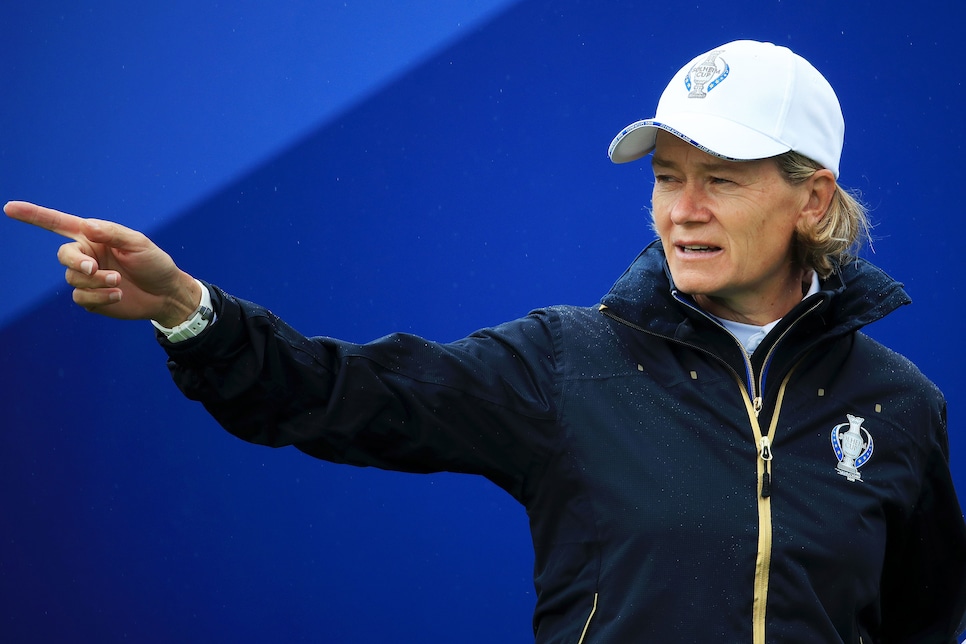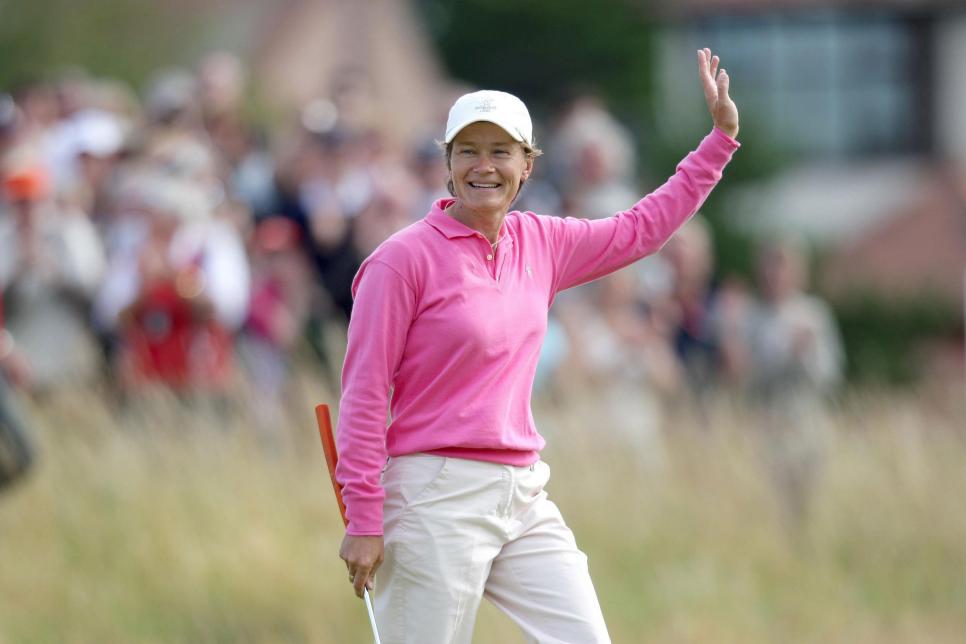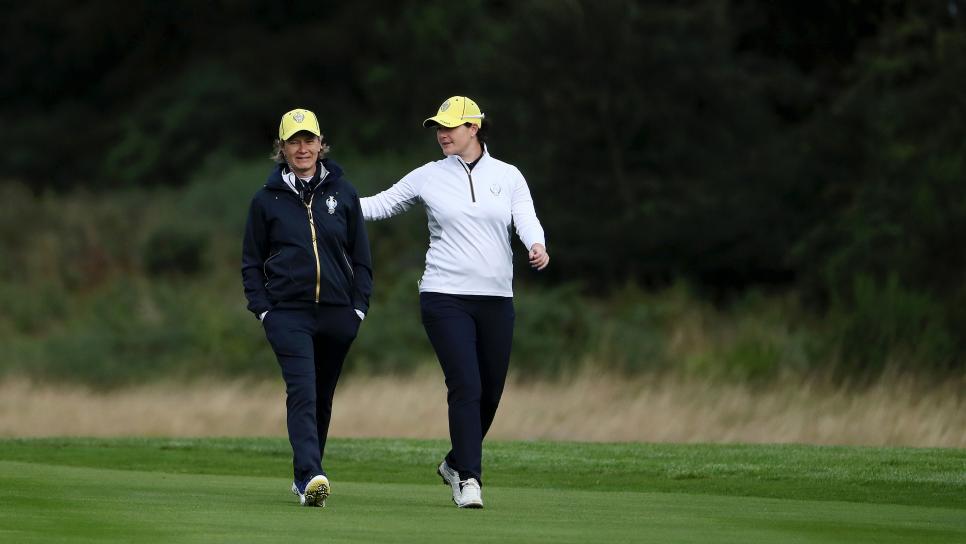News
Solheim Cup 2019: The unassuming Catriona Matthew is the leader Europe needs to end its losing skid

This was five years ago, but it could just as easily have happened last week. Standing by a scoreboard outside the clubhouse at North Berwick in East Lothian, Scotland, a journalist, there to cover qualifying for the Open Championship, happened to glance to his left. Carrying a shopping bag, a woman was quietly walking past with her two young children. No one else noticed her, never mind looked at her twice.
Days earlier that same woman had finished in the top 10 at the U.S. Women’s Open. Five years before, she had won the Women’s British Open, only nine weeks after giving birth to Sophie, her second daughter. Yet no one noticed this major champion as she strolled alongside the course where she grew up.
It’s always been that way for Catriona Matthew. Even in Scotland, a nation starved of golfing heroes—male or female—over the past few years, recognition has always been elusive. Part of that comes from the still-lingering bias against females within golf. Part is her personality—few in the game are more unassuming. And the rest can be attributed to a widely held ignorance of women’s sport that is only now, in the 21st century, eroding.
To be fair, Matthew’s public profile has risen recently as she has assumed the role that will fully occupy her thoughts over the next few days. As the captain of the 2019 European Solheim Cup team, Matthew—or Beany as she is known to those close to her—has been charged with regaining the trophy that has been in American hands since 2015. In her homeland. In front of her “ain folk.”
So no pressure, then, for this nine-time playing veteran of the biennial match who has twice holed the winning putt for her side and who, as such, commands the respect of just about everyone she has encountered during her 24-year professional career.
“We always looked at Beany as something of a silent assassin,” says Dottie Pepper, a six-time U.S. Solheim Cup player and contemporary of Matthew’s. “She certainly wasn’t someone you wanted to play against. I always thought of her as being like someone who was ‘sneaky long.’ You underestimated her at your peril. She was always better than you expected at first glance. She was efficient, nothing flashy, but she always knew how to get the ball in the hole.”
Indeed, in many ways Matthew, who had an 18-11-8 record in the Solheim Cup, going 6-2-1 in singles, possessed almost the perfect game and temperament for match-play golf. The off-course calmness transformed into something not far short of inscrutability when she walked inside the ropes. Combined with the steadiness and sureness of her long game, opponents never gained encouragement from any negative body language. Impassive whatever the circumstances, Matthew gave nothing away.
In no way, however, does that mean she couldn’t make a point with her clubs. In 2011 at Killeen Castle in Ireland, with Europe and the United States tied going into the final day, Matthew was chosen to play in the top match against Paula Creamer, who until then was unbeaten in Solheim Cup singles.
“I recall that the weather wasn’t great, which helped us, I think,” says Matthew, who won the match, 6 and 5. “Being off first was a great honor, especially as we needed a fast start if we were to win the trophy. I certainly felt like I had to win. Not just for myself, but for the boost that would give those coming along behind.”
A boost, indeed. Following Matthew’s lead, the Europeans went 5-4-2 in the remaining matches to win the Cup, 15-13.
“I remember standing on the first tee,” Matthew says. “There was a strong wind that made it difficult to carry the fairway bunker. But I stood up and hit one of the best drives of my life, miles over the bunker and well past Paula. That seemed to set the tone for the match. I think she noticed, anyway.”

Martin Rickett - PA Images
Only Matthew’s putting, forever the relative weakness in her game, stopped her from winning more. A glance at her career record reveals a plethora of top 10s but only 10 victories (six in Europe, three on the LPGA Tour and one in Australia), a sure sign that making the putts when they really mattered was just about the only thing she lacked day-to-day.
Still, added together, all of the above will surely combine to make Matthew a leader held in high regard. “I think she will be a terrific captain,” Pepper says, “one who will listen to what everyone else has to say, then make up her own mind about things.”
That sounds about right. Over the last few months Matthew has consulted with past Ryder and Solheim Cup captains and players like Thomas Bjorn, Paul McGinley, Colin Montgomerie, Alison Nicholas and Helen Alfredsson, gathering “little bits” from all of them.
“The common theme was how important communication is,” Matthew says. “The players like to know what is going on. As much as possible, I’ll be keeping them informed.”
So, although Matthew might not be one for offering unsolicited opinions (at least publicly), the accounting graduate from the University of Stirling has never been accused of being incapable of making her own decisions. That much is already apparent. Having already talked the previously reluctant Laura Davies into being one of her assistants this week at Gleneagles, Matthew went right ahead and selected a woman who had barely played competitive golf for two years, Suzann Pettersen, as one of Europe’s captain’s picks. These are not the actions of someone who does not know her own mind.
“My picks do seem to have caused a bit of fuss,” says Matthew, displaying a knowing smile. “But what I have come to realize over the course of my Solheim Cup career is that the picks are up to the captain. No one else. Which is why I went with what my gut was telling me. I feel a lot better about my picks knowing that it was all down to me. I didn’t want to be walking around thinking I’d selected people just because everyone else thought I should.
“I’m sure I will get second-guessed about Suzann,” Matthew says. “But I’ve seen her up close recently, and she is hitting it great. Her experience in the matches will be invaluable. She has a great Solheim record. This will be her ninth appearance. … In the Solheim, you don’t necessarily have to play your best golf, you just have to gut it out and beat your opponent. Suzann knows how to do that, almost better than anyone.”
[RELATED: Airlines lose clubs for not one but two Solheim Cup golfers](https://www.golfdigest.com/story/european-solheim-cup-player-jodi-ewart-shadoff-clubs-were-lost-by-airline-havent-arrived-in-scotland-yet
There isn’t much Matthew needs to learn about the sometimes dark art of match play. Even before she turned professional, she excelled in that arena. Three times the Scottish Ladies champion, she also won the British title and played for Great Britain & Ireland in three Curtis Cups.
“I’ve always enjoyed match play and the team aspect of the Solheim Cup,” says Matthew, who turned 50 last month. “It takes me back to my amateur days in many ways. Off the course it’s just a lot of fun and not just another week on tour. And on the course, I’ve always relished the prospect of playing others head-to-head. It makes a nice change from playing the course every week.”
Matthew’s approach to the captain’s role this week will be at once obvious and critical.
“As one of the more experienced members of the team, I’ve always tried to make myself available to answer any questions the younger players might have,” Matthew says. “And in the last couple of matches, I’ve played with rookies like Sandra Gal, Diana Luna and Azahara Munoz. It’s hard to explain to them how different the Solheim Cup is, though. They all want to know what it is like on the first tee, but until they are standing on their feeling it, they won’t really know. It’s impossible to put into words, really.”

Jamie Squire/WME IMG
There is one aspect of the Solheim experience in which Matthew will likely fail to exert an influence this week: air-hugging. Like Davies, the European skipper is not a fan of the post-round practice that pervades much of the LPGA Tour, going as far as leading an ultimately unsuccessful campaign to bring back the handshake a few years ago.
Looking ahead, Matthew will be concerning herself with more weighty matters. Who plays with who, for example. And, again, few are more qualified to come to these vital conclusions. Over the course of her nine Solheim Cups, Matthew took on the Americans alongside as many as 13 different partners. So it is that, in their practice rounds, Matthew is aiming to give her team “a bit of structure.” There will be some money matches. And she will want those likely to play foursomes together to spend time working out who drives on what holes.
“I want my players to have as much time as possible to prepare for the tee shots they are going to hit,” she says. “Along with my vice-captains [Kathryn Imrie and Mel Reid are the others], I’ve put a lot of thought into the pairings. I’ve spoken to a few of the players, too. They all have their own ideas. What I haven’t heard from any is that they don’t want to play with someone else. So that’s good. There are no issues in that respect.”
Not surprisingly, Matthew intends to put similar personalities together in foursomes and four-balls. “A big key for me is being relaxed with the person you are playing with,” Matthew says. “I did my best with players with similar temperaments to my own. I never played with Suzann. I never played with Carlota [Ciganda]. I never played with Mel. They might all be perceived as a bit more fiery than me. So I played with the likes of Sandra Gal and Karine Icher. It isn’t that we wanted to win any less than anyone else. We just don’t show it outwardly as much.”
As for the Centenary course at Gleneagles, where Europe beat the U.S. handedly in the 2014 Ryder Cup, Matthew claims to have had only minimal input into the course set-up. She is looking for a “good test, but not too tough.” So the fairways will be generous, with many greens surround by run-offs to provide multiple options when it comes to chipping. Matthew is no fan of the one-dimensional game encouraged by long rough around putting surfaces.
“I think the spectators want to see holes won with birdies,” she says. “That way, the crowd gets into it more.”
In the end, of course, the success or failure of Matthew’s captaincy will be out of her hands. As ever, it will come down to how well her players perform and, most important, how well they putt relative to the opposition. Which sounds a lot like the lady herself, come to think of it.

